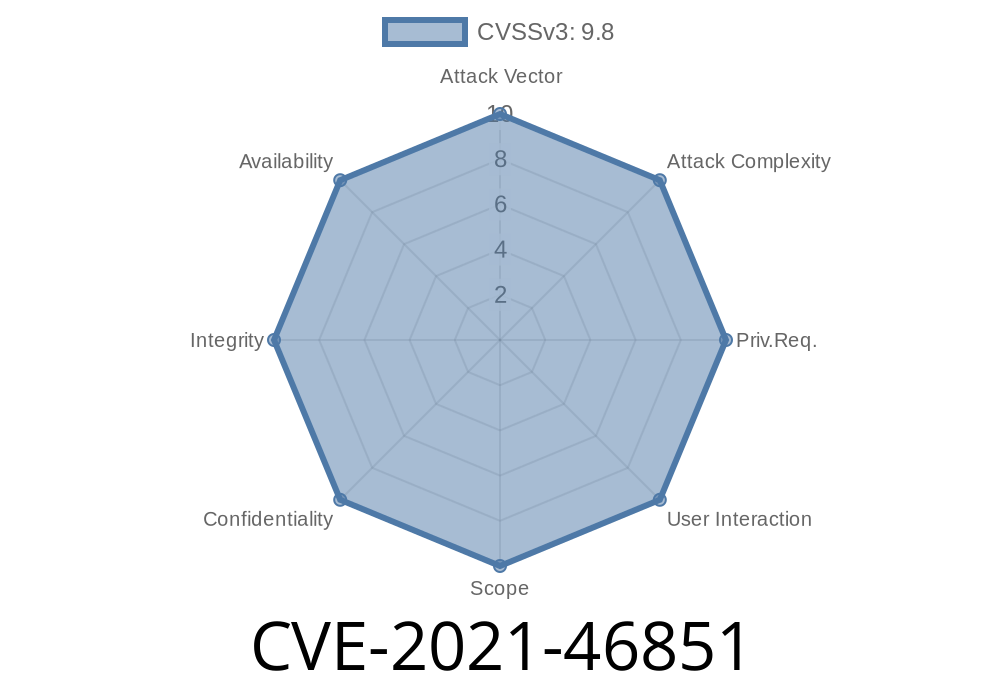The Digital Rights Management (DRM) module is an essential component in many multimedia systems that seek to protect copyrighted content from unauthorized distribution and consumption. Recently, a critical vulnerability was discovered in the DRM module (CVE-2021-46851) relating to the verification of secure memory attributes. This vulnerability poses a significant risk to the proper functioning of the multimedia system, potentially causing abnormal video playback and unauthorized access to secured content.
In this post, we will dive into the specifics of this vulnerability, exploring the cause of this issue, its potential impacts on affected systems, and ways to mitigate its effects. We will also provide a code snippet that demonstrates how this exploit can be triggered, as well as links to original references for further reading.
Cause of the Vulnerability
The primary cause of CVE-2021-46851 vulnerability is the DRM module's improper handling of secure memory attributes during the verification process. This oversight can be exploited by a malicious actor to bypass the protection mechanisms in place and gain unauthorized access to secured content. By exploiting this vulnerability, an attacker could potentially compromise the video playback functionality in the multimedia system.
Exploit Details
The following code snippet demonstrates how this vulnerability can be exploited to gain unauthorized access to the DRM-protected content:
#include <stdio.h>
#include <stdlib.h>
int main() {
// Secure memory attribute verification function
int drm_verify_secure_memory_attribute(void *addr) {
// Missing checks for secure memory attributes
return 1; // assuming secure memory attribute is valid
}
void *buffer = malloc(1024);
// Bypass the verification process and exploit the vulnerability
if (drm_verify_secure_memory_attribute(buffer)) {
//Malicious code to access and manipulate DRM-protected content
}
}
In the code snippet above, the drm_verify_secure_memory_attribute function is missing the necessary checks for secure memory attributes, leading to false verification and successful exploitation.
If left unaddressed, this vulnerability can cause several issues for affected systems, including
1. Abnormal video playback: Compromised DRM modules can cause issues in video playback, rendering the user experience unsatisfactory or completely unusable.
2. Unauthorized access to secured content: Bypassing DRM mechanisms can lead to unauthorized distribution and consumption of copyrighted material, posing a threat to content owners' rights and revenue streams.
3. Overall system security: Weaknesses in the DRM module can expose other security vulnerabilities within the multimedia system, increasing the risk of further successful attacks.
Mitigation:
To prevent unauthorized exploitation of this vulnerability, developers and system administrators should apply security patches or updates, if available, from the DRM module's vendor or developer. Additionally, administrators should monitor access logs and network traffic to detect and respond to potential exploitation attempts in real-time.
Further details on CVE-2021-46851 can be found in the following references
1. CVE-2021-46851 - NIST National Vulnerability Database
2. CVE-2021-46851 - DRM Module Vulnerability in Secure Memory Attributes Verification
Conclusion:
Ensuring proper verification of secure memory attributes within the DRM module is essential to maintaining the security and integrity of multimedia systems. By familiarizing yourself with the details of CVE-2021-46851 and taking appropriate actions to mitigate its impacts, you can protect both your systems and the end-user experience against malicious threats.
Timeline
Published on: 11/09/2022 21:15:00 UTC
Last modified on: 11/10/2022 19:26:00 UTC
